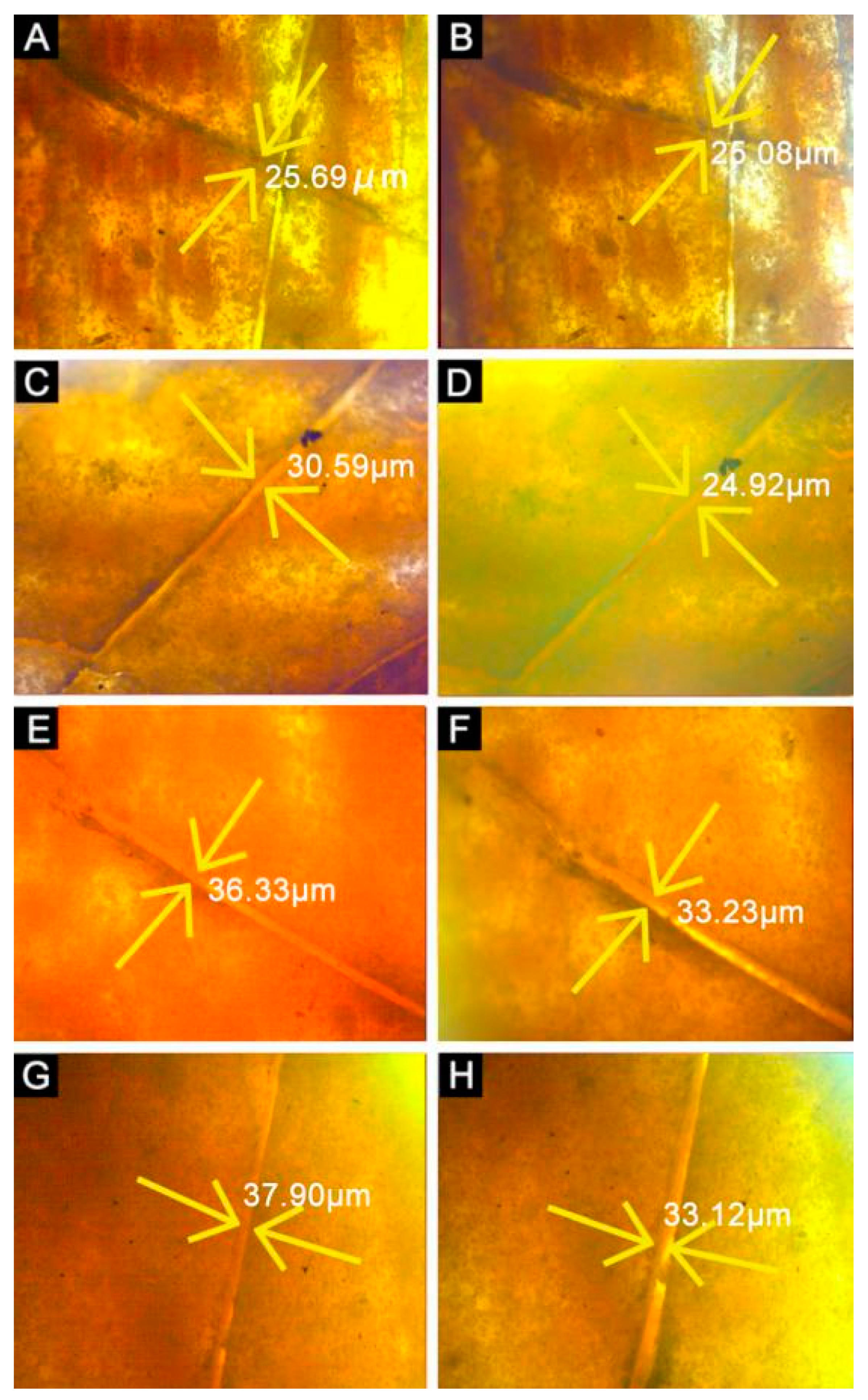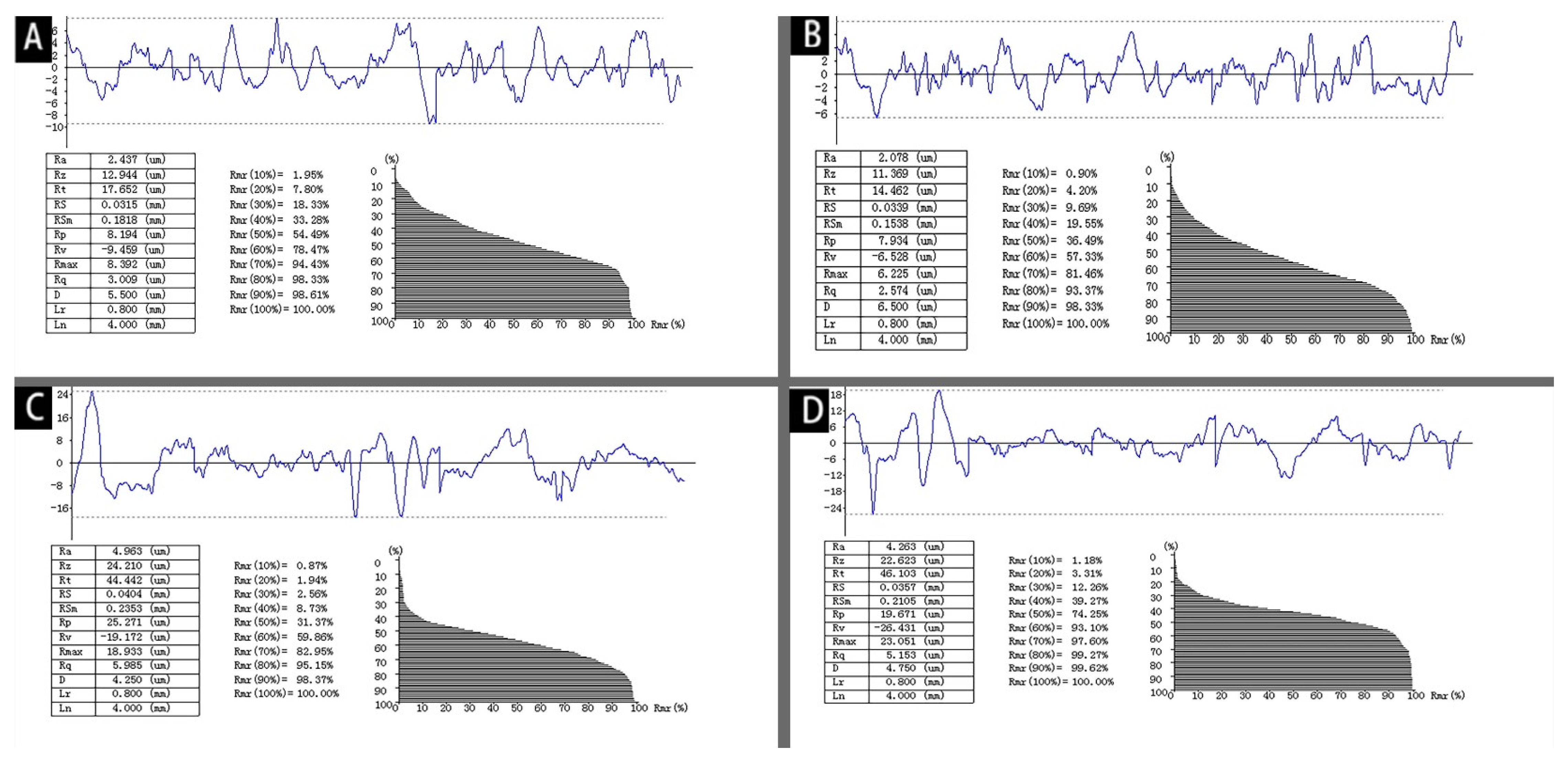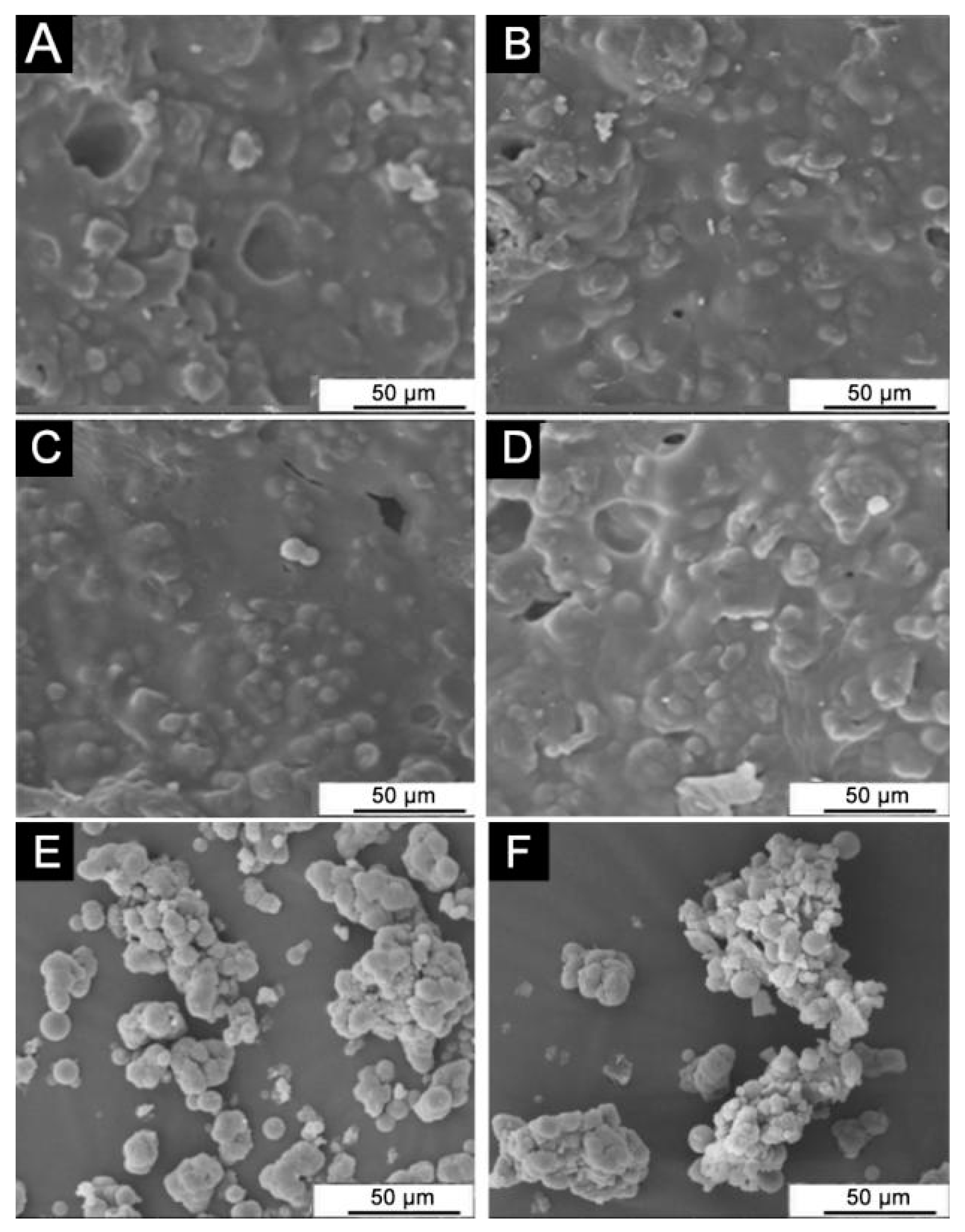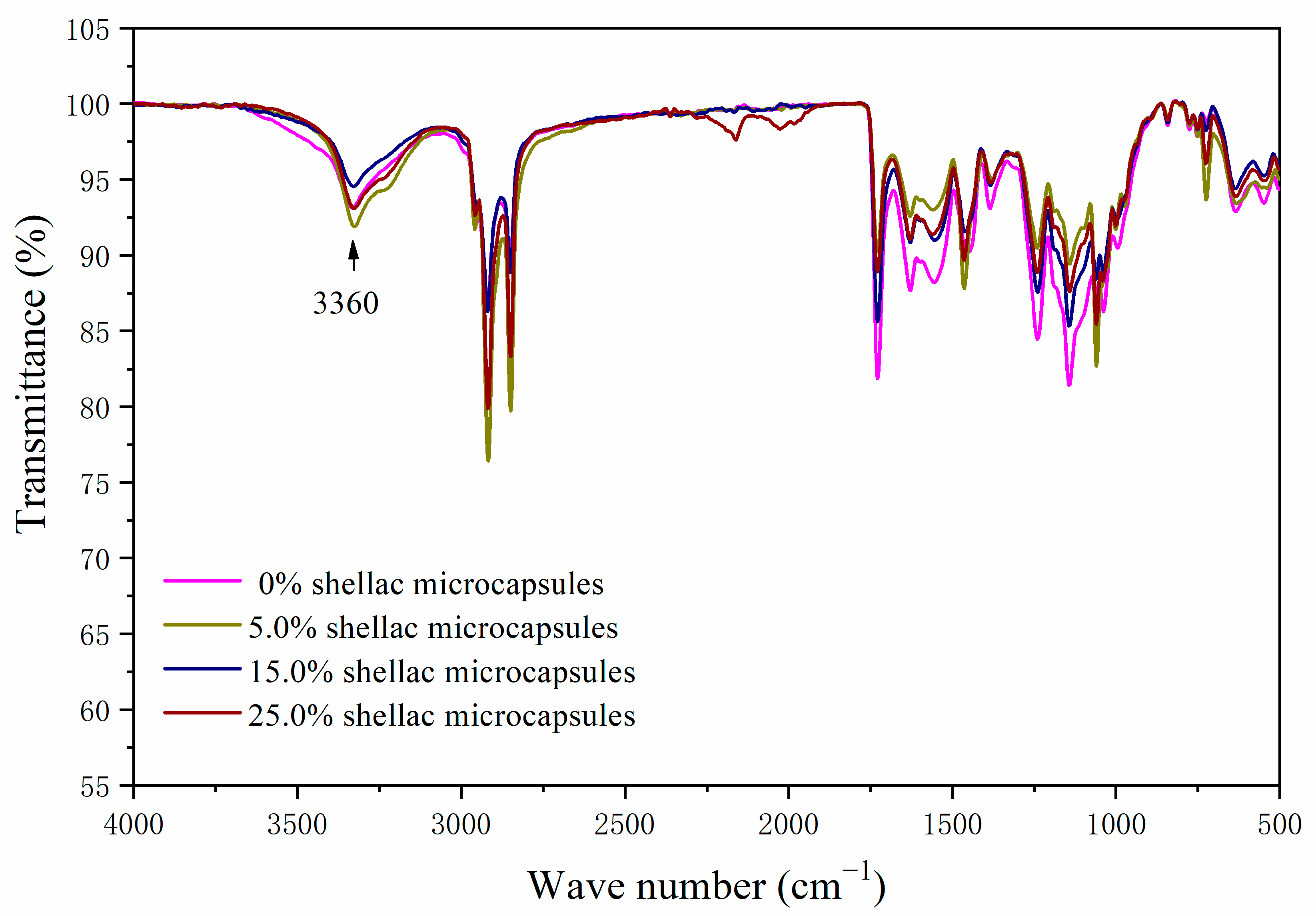Effect of the Addition of Shellac Self-Healing and Discoloration Microcapsules on the Performance of Coatings Applied on Ebiara Solid Board
Abstract
:1. Introduction
2. Materials and Methods
2.1. Experimental Materials
2.2. Coating Preparation
2.2.1. Preparation of Shellac Microcapsules
2.2.2. Preparation of Discoloration Microcapsules
2.2.3. Preparation of Coating
2.3. Testing and Characterization
3. Results and Discussion
3.1. Color Difference Analysis
3.2. Self-Healing Experiment
3.3. Roughness Analysis
3.4. Hardness Analysis
3.5. Microstructure Analysis
3.6. Infrared Spectroscopy
4. Conclusions
Author Contributions
Funding
Institutional Review Board Statement
Informed Consent Statement
Data Availability Statement
Conflicts of Interest
References
- Ozgenc, O.; Durmaz, S.; Sahin, S.; Boyaci, I.H. Evaluation of the weathering resistance of waterborne acrylic and alkyd-base films containing HALS, UV absorber, and bark extracts on wood surfaces. J. Coat. Technol. Res. 2020, 17, 461–475. [Google Scholar] [CrossRef]
- Fu, R.; Zhang, W.; Li, D.; Zhang, H. Analyses on chemical composition of ancient wood structural component by using near infrared spectroscopy. J. For. Eng. 2021, 6, 114–119. [Google Scholar]
- Wu, S.-S.; Tao, X.; Xu, W. Thermal Conductivity of Poplar Wood Veneer Impregnated with Graphene/Polyvinyl Alcohol. Forests 2021, 12, 777. [Google Scholar] [CrossRef]
- Li, R.; He, C.; Chen, Y.; Wang, X. Effects of laser parameters on the width of discoloration area of poplar wood surface during a single irradiation. Eur. J. Wood Wood Prod. 2021, 79, 1109–1116. [Google Scholar] [CrossRef]
- Hu, J.; Liu, Y.; Wu, Z.; Pang, X. Construction of bionic structural color coating on wood surface based on polystyrene microspheres. J. For. Eng. 2021, 6, 35–42. [Google Scholar]
- Liu, Q.; Gu, Y.; Xu, W.; Lu, T.; Li, W.; Fan, H. Compressive Properties of Green Velvet Material Used in Mattress Bedding. Appl. Sci. 2021, 11, 11159. [Google Scholar] [CrossRef]
- Xu, W.; Chen, P.; Yang, Y.; Wang, X.; Liu, X. Effects of freezing and steam treatments on the permeability of Populus tomentosa. Mater. Werkst. 2021, 52, 907–915. [Google Scholar] [CrossRef]
- Lu, Z.; Hu, J.; Zhang, M.; Chang, S.; Liu, Y.; Zheng, L.; Li, X. Research on wettability of wood surface with waterborne-resin priming paint. J. For. Eng. 2021, 6, 178–183. [Google Scholar]
- Yang, Y.; Xu, W.; Liu, X.; Wang, X. Study on permeability of cunninghamia lanceolata based on steam treatment and freeze treatment. Wood Res. 2021, 66, 721–731. [Google Scholar] [CrossRef]
- Li, R.; Fang, L.; Xu, W.; Xiong, X.; Wang, X.A. Effect of Laser Irradiation on the Surface Wettability of Poplar Wood. Sci. Adv. Mater. 2019, 11, 655–660. [Google Scholar] [CrossRef]
- Xu, W.; Fang, X.; Han, J.; Wu, Z.; Zhang, J. Effect of Coating Thickness on Sound Absorption Property of Four Wood Species Commonly Used for Piano Soundboards. Wood Fiber Sci. 2020, 52, 28–43. [Google Scholar] [CrossRef] [Green Version]
- Feng, X.; Chen, J.; Wu, Z.; Wu, Y.; Gan, J. The formation mechanism of “skin-tactile” coating and its application and trends in furniture. J. For. Eng. 2021, 6, 167–175. [Google Scholar]
- Zhao, Y.; Ren, J.; Zheng, X.; Pan, B.; Leng, W. Effects of three kinds of fungi on color, chemical composition and route of in-fection of Picea sitchensis. J. For. Eng. 2021, 6, 88–93. [Google Scholar]
- Liu, Y. Self-assembly of poly(styrene-methyl methacrylate-acrylic acid) (P(St-MMA-AA)) colloidal microspheres on wood surface by thermal-assisted gravity deposition. Wood Sci. Technol. 2021, 55, 403–417. [Google Scholar] [CrossRef]
- Liu, Y.; Hu, J.; Wu, Z. Fabrication of Coatings with Structural Color on a Wood Surface. Coatings 2020, 10, 32. [Google Scholar] [CrossRef]
- Agnol, L.D.; Dias, F.T.G.; Ornaghi, H.L.; Sangermano, M.; Bianchi, O. UV-curable waterborne polyurethane coatings: A state-ofthe-art and recent advances review. Prog. Org. Coat. 2021, 154, 106156. [Google Scholar] [CrossRef]
- Liu, Q.Q.; Gao, D.; Xu, W. Influence of the bottom color modification and material color modification process on the perfor-mance of modified Poplar. Coatings 2021, 11, 660. [Google Scholar] [CrossRef]
- Revuelta, M.; Bogdan, S.; Gámez-Espinosa, E.; Deyá, M.; Romagnoli, R. Green antifungal waterborne coating based on essential oil microcapsules. Prog. Org. Coat. 2020, 151, 106101. [Google Scholar] [CrossRef]
- Yan, X.; Peng, W. Preparation of Microcapsules of Urea Formaldehyde Resin Coated Waterborne Coatings and Their Effect on Properties of Wood Crackle Coating. Coatings 2020, 10, 764. [Google Scholar] [CrossRef]
- Liu, Y.; Hu, J. Investigation of Polystyrene-Based Microspheres from Different Copolymers and Their Structural Color Coatings on Wood Surface. Coatings 2020, 11, 14. [Google Scholar] [CrossRef]
- Busch, L.; Avlasevich, Y.; Zwicker, P.; Thiede, G.; Landfester, K.; Keck, C.M.; Meinke, M.C.; Darvin, M.E.; Kramer, A.; Müller, G.; et al. Release of the model drug SR101 from polyurethane nanocapsules in porcine hair follicles triggered by LED-derived low dose UVA light. Int. J. Pharm. 2021, 597, 120339. [Google Scholar] [CrossRef] [PubMed]
- Zhu, X.D.; Liu, Y.; Li, Z.; Wang, W.C. Thermochromic microcapsules with highly transparent shells obtained through in-situpolymerization of urea formaldehyde around thermochromic cores for smart wood coatings. Sci. Rep. 2018, 8, 4015. [Google Scholar] [CrossRef] [PubMed] [Green Version]
- Pedaballi, S.; Li, C.-C.; Song, Y.-J. Dispersion of microcapsules for the improved thermochromic performance of smart coatings. RSC Adv. 2019, 9, 24175–24183. [Google Scholar] [CrossRef] [PubMed] [Green Version]
- Park, S.; Cho, Y.; Park, S.; Oh, M.; Kim, D.; Lim, G.; Park, J.-J. Polyurea Microcapsules with Different Phase Change Material for Thermochromic Smart Displays. Chem. Lett. 2019, 48, 1343–1346. [Google Scholar] [CrossRef]
- Zhao, W.; Yan, X. Preparation of Thermochromic Microcapsules of Bisphenol A and Crystal Violet Lactone and Their Effect on Coating Properties. Polymers 2022, 14, 1393. [Google Scholar] [CrossRef]
- Chang, Y.; Yan, X. Preparation and Self-Repairing Properties of MF-Coated Shellac Water-Based Microcapsules. Coatings 2020, 10, 778. [Google Scholar] [CrossRef]
- GB/T 11186.3-1989; Methods for Measuring the Colour of Paint Films. Part III: Calculation of Colour Differences. Standardization Administration of the People’s Republic of China: Beijing, China, 1990.
- GB/T 6739-2006; Paint and Varnishes-Determination of Film Hardness by Pencil Test. Standardization Administration of the People’s Republic of China: Beijing, China, 2006.





| Sample | Content of Discoloration Microcapsules (%) | Shellac Microcapsule Content (%) | Addition Method |
|---|---|---|---|
| PD10TS5 | 10.0 | 5.0 | Primer added with the discoloration microcapsules, topcoat added with the shellac microcapsules |
| PS15TD10 | 10.0 | 15.0 | Topcoat added with the discoloration microcapsules, primer added with the shellac microcapsules |
| PS5TD20 | 20.0 | 5.0 | Topcoat added with the discoloration microcapsules, primer added with the shellac microcapsules |
| PD20TS15 | 20.0 | 15.0 | Primer added with the discoloration microcapsules, topcoat added with the shellac microcapsules |
| PS0TD20 | 20.0 | 0 | Topcoat with discoloration microcapsules |
| PS5TD20 | 20.0 | 5.0 | Primer added with the shellac microcapsules, topcoat added with the discoloration microcapsules |
| PS10TD20 | 20.0 | 10.0 | |
| PS15TD20 | 20.0 | 15.0 | |
| PS20TD20 | 20.0 | 20.0 | |
| PS25TD20 | 20.0 | 25.0 | |
| PT | 0 | 0 | No microcapsules |
| Sample | L | a | b | c | h | L’ | a’ | b’ | c’ | h’ | ΔL | Δa | Δb | ΔE |
|---|---|---|---|---|---|---|---|---|---|---|---|---|---|---|
| PD10TS5 | 52.8 | 8.7 | 24.5 | 26.0 | 70.3 | 51.6 | 9.7 | 23.7 | 25.6 | 67.6 | −1.2 | 1.0 | −0.8 | 1.8 |
| PS15TD10 | 62.6 | 11.9 | 29.0 | 31.4 | 67.6 | 58.6 | 11.1 | 23.8 | 26.2 | 64.9 | −4.0 | −0.8 | −5.2 | 6.6 |
| PS5TD20 | 69.2 | 7.3 | 15.1 | 16.8 | 64.1 | 64.8 | 8.4 | 13.3 | 15.8 | 57.5 | −4.4 | 1.1 | −1.8 | 4.9 |
| PD20TS15 | 55.3 | 11.6 | 16.4 | 20.2 | 54.9 | 63.6 | 8.5 | 13.0 | 15.5 | 56.7 | 8.3 | −3.1 | −3.4 | 9.5 |
| Sample | Content of Discoloration Microcapsules (%) | Shellac Microcapsule Content (%) | Microcapsule Addition | The Color Difference |
|---|---|---|---|---|
| PD10TS5 | 10.0 | 5.0 | Primer added with the discoloration microcapsules, topcoat added with the shellac microcapsules | 1.8 |
| PS15TD10 | 10.0 | 15.0 | Topcoat added with the discoloration microcapsules, primer added with the shellac microcapsules | 6.6 |
| PS5TD20 | 20.0 | 5.0 | Topcoat added with the discoloration microcapsules, primer added with the shellac microcapsules | 4.9 |
| PD20TS15 | 20.0 | 15.0 | Primer added with the discoloration microcapsules, topcoat added with the shellac microcapsules | 9.5 |
| Mean 1 | 4.200 | 3.350 | 5.650 | - |
| Mean 2 | 7.200 | 8.050 | 5.750 | - |
| Range | 3.000 | 4.700 | 0.100 | - |
| Sample | L | a | b | c | h | L’ | a’ | b’ | c’ | h’ | ΔL | Δa | Δb | ΔE |
|---|---|---|---|---|---|---|---|---|---|---|---|---|---|---|
| PS0TD20 | 57.7 | 10.5 | 20.7 | 23.2 | 63.0 | 65.8 | 11.5 | 22.7 | 25.4 | 63.0 | 8.1 | 1.0 | 2.0 | 8.4 |
| PS5TD20 | 67.0 | 10.5 | 19.5 | 22.1 | 61.6 | 65.1 | 8.7 | 16.5 | 18.6 | 62.0 | −1.9 | −1.8 | −3.0 | 4.9 |
| PS10TD20 | 67.4 | 8.3 | 13.8 | 16.1 | 58.8 | 70.7 | 9.5 | 16.4 | 19.0 | 59.9 | 3.3 | 1.2 | 2.6 | 4.4 |
| PS15TD20 | 65.6 | 7.6 | 11.5 | 13.8 | 56.6 | 71.8 | 8.8 | 14.1 | 16.7 | 58.9 | 6.2 | 1.2 | 2.6 | 6.8 |
| PS20TD20 | 71.0 | 3.6 | 14.1 | 14.6 | 75.4 | 76.5 | 7.3 | 13.8 | 15.6 | 61.9 | 5.5 | 3.7 | −0.3 | 6.6 |
| PS25TD20 | 75.5 | 5.8 | 11.9 | 13.2 | 64.0 | 79.2 | 6.1 | 12.3 | 13.7 | 63.3 | 3.7 | 0.3 | 0.4 | 3.7 |
| PT | 62.1 | 10.2 | 38.8 | 40.1 | 67.1 | 62.0 | 10.7 | 34.9 | 36.5 | 72.8 | −0.1 | 0.5 | −3.9 | 3.9 |
| Sample | Before the Repair (μm) | After the Repair (μm) | Difference (μm) |
|---|---|---|---|
| PS0TD20 | 25.69 | 25.08 | 0.61 |
| PS5TD20 | 30.59 | 24.92 | 5.67 |
| PS15TD20 | 36.33 | 33.23 | 3.10 |
| PS25TD20 | 37.90 | 33.12 | 4.78 |
| Sample | PS0TD20 | PS5TD20 | PS15TD20 | PS25TD20 |
|---|---|---|---|---|
| Roughness (μm) | 2.437 | 2.078 | 4.963 | 4.263 |
| Sample | PS0TD20 | PS5TD20 | PS15TD20 | PS25TD20 |
|---|---|---|---|---|
| Hardness | 5H | 5H | 6H | 5H |
Publisher’s Note: MDPI stays neutral with regard to jurisdictional claims in published maps and institutional affiliations. |
© 2022 by the authors. Licensee MDPI, Basel, Switzerland. This article is an open access article distributed under the terms and conditions of the Creative Commons Attribution (CC BY) license (https://creativecommons.org/licenses/by/4.0/).
Share and Cite
Qin, Y.; Yan, X. Effect of the Addition of Shellac Self-Healing and Discoloration Microcapsules on the Performance of Coatings Applied on Ebiara Solid Board. Coatings 2022, 12, 1627. https://doi.org/10.3390/coatings12111627
Qin Y, Yan X. Effect of the Addition of Shellac Self-Healing and Discoloration Microcapsules on the Performance of Coatings Applied on Ebiara Solid Board. Coatings. 2022; 12(11):1627. https://doi.org/10.3390/coatings12111627
Chicago/Turabian StyleQin, Yanzhao, and Xiaoxing Yan. 2022. "Effect of the Addition of Shellac Self-Healing and Discoloration Microcapsules on the Performance of Coatings Applied on Ebiara Solid Board" Coatings 12, no. 11: 1627. https://doi.org/10.3390/coatings12111627




